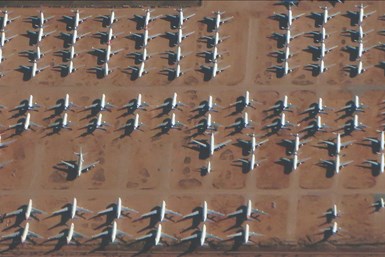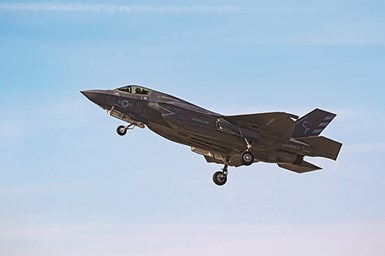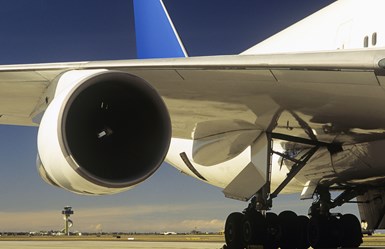
Aerospace production isn’t predicted to return to pre-pandemic levels until 2024. Where does that leave finishing operations in the aerospace supply chain? Photo credit: Products Finishing
The past couple of years have yielded a series of black swan events that have impacted manufacturing in every sector. The COVID-19 pandemic and everything that has come with it from supply chain disruptions to changing consumer behavior to workforce upheaval has led to a world that looks much different than a few years ago. The past couple of years have left our society anxious for a rebound, for COVID to subside — for things to be better. Everyone hoped that 2021 would usher out the bad air, but for the most part, it has been a year of constant anticipation. Given the impacts that the economy, supply chain, and different sectors of business suffered in the wake of a global pandemic, to expect some miraculous instant recovery is simply unrealistic.
One of the most glaring areas where we hang our hopes for this “return to normal” is the commercial aerospace industry. The disruption of travel in 2020 due to COVID was a large contributor to the unraveling of business and personal life. Suddenly the trade shows, networking events, shop tours and in- person meetings all but stopped. So, too, did the vacations, the quick getaways and the family get-togethers. All of this meant a reduction in airline passenger traffic, which in turn decreased the demand for new aircraft.
Featured Content
The commercial aerospace industry was dealt a serious blow. A reduction in airline passengers affected aircraft demand. According to many market reports, travel demand is not expected to return to pre–COVID-19 levels before 2024.

According to a recent article by aerospace industry veteran Mohamed Fawsy in Forbes magazine, air travel demand reached a peak in 2018, and a total of 1,606 aircraft were delivered from Airbus and Boeing. In 2020 international flights dropped 68% and domestic flights dropped 40%. Compiled with the grounding of Boeing’s 737 Max in 2019 due to faulty software that resulted in two fatal crashes, the manufacture of new aircraft came to a near standstill compared to previous levels. The repercussions have been felt through the entire aerospace supply chain. Boeing has some 12,000 suppliers that were affected by these events.
In the aforementioned Forbes article, Fawsy writes, “Manufacturers globally suffered between a 30% drop and a 50% drop in sales dependent on their customer portfolio, some manufacturers with a larger share of commercial aerospace portfolio saw between a 60%-70% drop.”

Many suppliers in the aerospace sector weathered the pandemic by turning focus to aerospace work in the defense sector.
Running defense
Many in the aerospace supply chain turned to their aerospace work in the defense sector to try to stay afloat. A good example is Valence Surface Technologies, headquartered in The Woodlands, Texas. With facilities strategically located across the U.S. to serve aviation, defense and space market sectors, Valence’s services include anodizing, conversion coating, passivation, plating, painting and non-destructive testing, among others. During the height of the pandemic, the company saw its commercial aerospace work dip from about 50% of its business to around 30%. Valence used the time to seek new approvals and put some additional focus on the defense and space markets.
“We were able to dedicate resources that might normally be doing quality on the floor and final inspections to help get approvals,” states Chris Grapsas, vice president of sales and marketing for Valence. “A big initiative has been to continue to grow our offerings, adding processes for commercial programs, defense programs, space programs and advanced systems.”
Many businesses in the aerospace supply chain made similar pivots, seeking new work in the defense sector from companies like Lockheed Martin and Northrop Grumman, as well as space work from such companies as Blue Origin and Space-X. By and large, defense work has remained somewhat stable throughout the crisis and continues to do so.
The October 2020 issue of Products Finishing features a round-up of Valence’s approvals during the height of the pandemic. Read the full article here: short.pfonline.com/defenseapprovals
Kurt Weamer, director of sales and marketing for Wolkerstorfer Co. Inc. (New Brighton, Minnesota), says that while the defense work has helped suppliers stay afloat, it doesn’t make up for the lost commercial aerospace work. Aircraft components are a large market for Wolkerstorfer and the company processes parts for multiple platforms. In 2020 that business came to a near standstill. In 2021 the company is beginning to see that business trickle back in, but the return is slow for that sector of the business.
“To give you an idea, I’d say pre-COVID our aerospace division was about 65% commercial, 35% defense,” Weamer says. “Under the current situation, it’s literally more than a flip flop of those percentages.”
“On a bright note, after being in business for over 126 years you know how to pivot. We have taken advantage of the time to invest in the value of our team by cross-training, updated key support equipment and existing technology. The perpetual evaluation of a business and market strategies continues to be in the foreground. As the market rebounds, we are now in a better position to take advantage of those new opportunities.”
Weamer points out that while defense projects have big budgets, the number of planes produced is on a much smaller scale than creating planes for a commercial fleet. All to say that defense makes up a smaller portion of suppliers’ portfolios in comparison to what they count on from commercial aerospace. He puts it this way, “Defense pays a lot of bills, but it doesn’t generate a lot of volume.”

More than 16,000 planes were grounded by airlines during the COVID-19 pandemic.
A question of inventory
There is no question that commercial aerospace demand and the manufacture of new planes will continue to ramp back up. Yet, the question is how long it will take for suppliers to the sector to see new business.
“I think what we’ve really learned throughout all of this is that inventory positions were a bit unknown throughout the entire supply chain,” Grapsas says.
All this to say that there are aircraft parts sitting on many suppliers’ shelves waiting to be put on a plane.
“When COVID hit and the planes went down there was already a massive amount of material that was already in the supply chain pipeline,” Weamer says.
“It’s an ungodly amount of inventory to sit on,” he says. “Now the industry is working through that inventory and it’s starting to get to the point that we’re hearing better things, but full market recovery will take some time.”
Slowly but surely
While travel has grown year over year, the drop-off in 2020 was so extreme that even with exponential growth, domestic travel is at around 80% of where it was in 2019 and international is at around 50%.
The slow return of demand isn’t the only challenge. Workforce is also currently a big hurdle for aerospace. Finishing operations and the entirety of manufacturing has been coping with the challenges of finding and retaining skilled labor for years and the COVID pandemic has exacerbated the problem. The labor problem isn’t confined to making the planes either. From pilots to mechanics, workforce shortages for keeping planes in the air is a challenge.
It’s not all gloom and doom. In the midst of the slowing of aircraft production, it seems that businesses have had time to refocus their sights on what the future of aerospace might look like. Work is being done to set the stage for next-generation aircraft and coatings are part of that equation, such as the following examples.
In February, PRI Qualification announced an Aerospace Coatings Applicator Specialist (ACAS) program aimed at allowing professional aerospace coatings applicators to earn industry-approved qualifications. Read the full story here: short.pfonline.com/programforcoating
In July, Oerlikon Balzers, a leading surface solutions brand of the Oerlikon Group, signed a 10-year contract with MTU Aero Engines to apply MTU’s owned erosion-resistant coating ERCoat on aerofoil components of next-generation GTF aero-engines used in the Airbus A320neo aircraft. The coating will help to further improve the efficiency of this engine. MTU Aero Engines is partnering with Pratt & Whitney on this engine. Read the story here: short.pfonline.com/oerlikonnextgen
In essence, it seems the industry is working to pick up where it left off and things should accelerate for suppliers as the backlog of inventory is used. Grapsas says, “Once the inventory position is flattened out across the board, you’ll see things start to pick up.”
RELATED CONTENT
-
Overview: Aerospace Anodize Finishes
The following anodizing process overviews are provided as a means of introduction to aerospace anodizing
-
Coating the Webb
From its signature primary mirror to thermal control for its instruments, the James Webb Space Telescope is enabled by gold coatings.
-
Evaluation of Hexavalent Chromium Free Bond Primers for Aerospace and Defense Applications
Three hex chrome free bond primers demonstrated that they can surpass the 960 hour threshold before exhibiting panel corrosion away from the scribe.




















